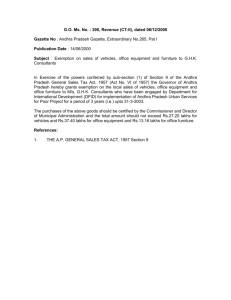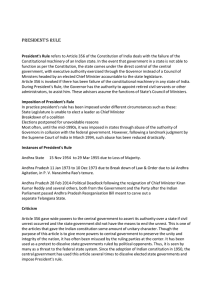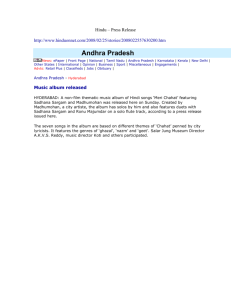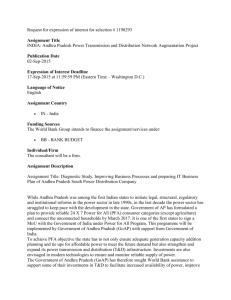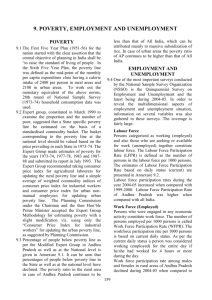Poverty, Employment and Unemployment
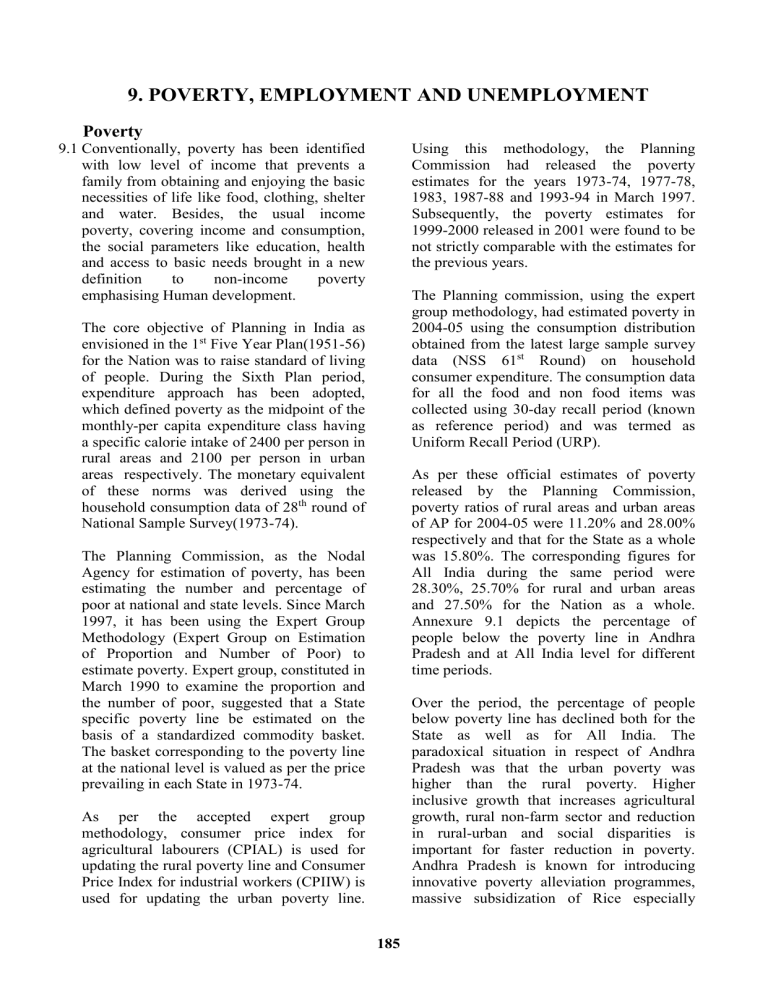
9. POVERTY, EMPLOYMENT AND UNEMPLOYMENT
Poverty
9.1 Conventionally, poverty has been identified with low level of income that prevents a family from obtaining and enjoying the basic necessities of life like food, clothing, shelter and water. Besides, the usual income poverty, covering income and consumption, the social parameters like education, health and access to basic needs brought in a new definition to non-income poverty emphasising Human development.
The core objective of Planning in India as envisioned in the 1 st
Five Year Plan(1951-56) for the Nation was to raise standard of living of people. During the Sixth Plan period, expenditure approach has been adopted, which defined poverty as the midpoint of the monthly-per capita expenditure class having a specific calorie intake of 2400 per person in rural areas and 2100 per person in urban areas respectively. The monetary equivalent of these norms was derived using the household consumption data of 28 th
round of
National Sample Survey(1973-74).
The Planning Commission, as the Nodal
Agency for estimation of poverty, has been estimating the number and percentage of poor at national and state levels. Since March
1997, it has been using the Expert Group
Methodology (Expert Group on Estimation of Proportion and Number of Poor) to estimate poverty. Expert group, constituted in
March 1990 to examine the proportion and the number of poor, suggested that a State specific poverty line be estimated on the basis of a standardized commodity basket.
The basket corresponding to the poverty line at the national level is valued as per the price prevailing in each State in 1973-74.
As per the accepted expert group methodology, consumer price index for agricultural labourers (CPIAL) is used for updating the rural poverty line and Consumer
Price Index for industrial workers (CPIIW) is used for updating the urban poverty line.
Using this methodology, the Planning
Commission had released the poverty estimates for the years 1973-74, 1977-78,
1983, 1987-88 and 1993-94 in March 1997.
Subsequently, the poverty estimates for
1999-2000 released in 2001 were found to be not strictly comparable with the estimates for the previous years.
The Planning commission, using the expert group methodology, had estimated poverty in
2004-05 using the consumption distribution obtained from the latest large sample survey data (NSS 61 st
Round) on household consumer expenditure. The consumption data for all the food and non food items was collected using 30-day recall period (known as reference period) and was termed as
Uniform Recall Period (URP).
As per these official estimates of poverty released by the Planning Commission, poverty ratios of rural areas and urban areas of AP for 2004-05 were 11.20% and 28.00% respectively and that for the State as a whole was 15.80%. The corresponding figures for
All India during the same period were
28.30%, 25.70% for rural and urban areas and 27.50% for the Nation as a whole.
Annexure 9.1 depicts the percentage of people below the poverty line in Andhra
Pradesh and at All India level for different time periods.
Over the period, the percentage of people below poverty line has declined both for the
State as well as for All India. The paradoxical situation in respect of Andhra
Pradesh was that the urban poverty was higher than the rural poverty. Higher inclusive growth that increases agricultural growth, rural non-farm sector and reduction in rural-urban and social disparities is important for faster reduction in poverty.
Andhra Pradesh is known for introducing innovative poverty alleviation programmes, massive subsidization of Rice especially
185
during the last two decades or so. Apart from the general economic policies and bold policy initiatives, the targeted poverty alleviation programmes like Velugu or Indira
Kranthi Patham
(IKP) for women’s empowerment, INDIRAMMA programme for providing housing and other infrastructure, pensions, land distribution and health insurance (Arogyasri) are the other important programmes helping the poor in various dimensions. Besides increasing the budgetary allocations, effective monitoring and improving delivery systems in poverty alleviation programmes will help reduce the severity of poverty.
EMPLOYMENT AND UNEMPLOYMENT
9.2 One of the most important surveys conducted by the National Sample Survey Organisation
(NSSO) is the Quinquennial Survey on
Employment and Unemployment and the latest being during 2004-05. In order to reveal the multidimensional aspects of employment and unemployment situation, information on several variables was also collected in these surveys. Persons who were engaged in any economic activity are termed as workers. Unpaid helpers who assisted in the operation of an economic activity are also considered as workers.
Labour Force
Persons categorized as working (employed) and also those who are seeking or available for work (unemployed) together constitute labour force. The labour force participation
Rate (LFPR) is defined as the number of persons in the labour force per 1000 persons.
The estimates of Labour Force participation
Rate based on daily status (current) are presented in Annexure 9.2.
Labour Force participation rates during the year 2004-2005 increased when compared with 1999-2000. Labour Force Participation rates both rural and urban areas of Andhra
Pradesh were higher when compared with all
India.
186
Work Force (Employed)
Persons who are engaged in any economic activity constitute the work force. The number of persons employed per 1000 persons is called Work Force Participation rate (WFPR). The work force participation rate per 1000 persons is based on current daily status. As per the current daily status, a person was considered working (employed) for the entire day if he/she had worked for 4 hours or more during the day.
Work force participation rate among males and females in rural areas of Andhra Pradesh declined during 2004-05 when compared to
1999-2000, whereas in urban areas of A.P it increased. Work force participation rates in general are high in Andhra Pradesh when compared with all India. Details are given in
Annexure 9.3.
Apart from the quantity of employment, quality is a concern in the state. Problems such as wage rate, seasonality, job insecurity, illiteracy, occupational hazards etc., continue in the state. Around 94% of the workers in
A.P. are in the unorganized sector and in fact, the state reports high incidence of employment in the unorganized/informal economy. Further, demographic dividend, which is one of the sources of future economic growth in Andhra Pradesh, is expected to increase the working age group and reduce dependency ratio. Reduction in dependency ratio is likely to increase savings and investments. Shifting the workforce from
Agriculture to the non-farm sector is an ideal way for enhancing the income levels of the poor by creating quality non-agriculture work opportunities through skill development in rural areas.
Employment Growth:
The main features of employment situation at
All India level as well as State level are summarized in Table 9.1.
Table 9.1
Employment Growth and Elasticity
Employment Growth and
Elasticity
Compound Annual
Growth Rate of
Employment (1993-94 to
1999-2000)
Compound Annual
Growth Rate of
Employment(1999-2000 to 2004-2005)
Employment Elasticity
(1993-94 to 1999-2000)
Andhra
Pradesh
1.44
2.65
0.11
All India
1.89
4.42
0.13
Employment Elasticity
(1999-2000 to 2004-05)
0.43 0.74
Source: Directorate of Economics and Statistics
The growth of employment in the State in the early reform period(1993-94 to 1999-2000) is relatively low when compared with that of
All India. Although, it has increased and almost doubled during the period 1999-2000 to 2004-05, rate of increase in employment in respect of All India is significantly high. The employment elasticity which represents the responsiveness of employment generation to change in gross domestic product, is low in both Andhra Pradesh and All India.
EMPLOYMENT AND TRAINING
9.3
Employment in Organized Sector
As per the Employment Marketing
Information (EMI) collected by Employment
Exchanges in Andhra Pradesh, there were
8,900 establishments in organized sector in
Andhra Pradesh at the end of March, 1966.
Out of these, 3,123 were in public Sector and
5,777 were in Private Sector. The number of establishments in the organized sector has now grown to 21,474 by March, 2009. Out of these, 13,668 were in Public Sector and
7,806 were in Private Sector.
20.83 lakhs persons were employed in the organized Sector as on March, 2009. The
Public Sector alone accounted for 13.57 lakhs and the remaining 7.26 lakhs were employed in Private Sector.
During the year 2009-10(upto Sept.09), a total of 88,107 candidates were enrolled, as many as 5,746 vacancies were notified to
Employment Exchanges and 693 candidates were placed. As many as 19,13,717
187 candidates were on the Live Register of
Employment Exchanges at the end of
September, 2009.
Employment in the Organised Sector in A.P.
(Public and Private Sectors) from March1966 to March 2009 is given in Annexure 9.4.
Rajiv Udyogasri:
Government has started a New Employment
Generation scheme with the aim of enabling ten lakhs jobs in private sector for the unemployed youth. To achieve this, a society called “Rajiv Udyogasri” has been set up in
July 2007 with the following objectives.
Objectives:
1.
To play the role of facilitator to unemployed youth and employers / industry.
2.
To achieve placements of atleast 10 lakhs youth in next 2 years, 5 lakhs in high end jobs in the IT & ITES sector and 5 lakhs in low end jobs in other sectors.
3.
To identify the employment potential.
4.
To impart necessary skills to the candidates so as to enable them to get absorbed in the private establishment.
The important line departments viz.,
MEPMA/MA&UD, Technical Education,
Intermediate Board, Collegiate Education,
Youth services, NAC, IEG, SC Corporation,
Minorities Welfare, AP Vikalangula
Cooperative Corporation, EGMM and
Employment and training, are undertaking employment generation activity in the shape of training the youth for the emerging opportunities and helping them be employed with the active coordination and consent of the private sector employers.
Before the setting up of this society as an umbrella organization to coordinate and consolidate, these Line departments had been engaged in employment generation activities and provided 1.98 lakhs placements during the period 2004 to 2007. The cumulative achievements enabled by these line departments upto October, 2009 (since,
2004) in employment generation are shown in the Table 9.2.
Table 9.2
Employment Generation by certain Line
Departments 2004-09 (upto Oct.09)
Department
Number
Placed
MA&UD/MEPMA
Technical education
70,608
60,958
Intermediate Board
Collegiate Education
Youth service
NAC
19,956
6,965
97,002
85,460
IEG
SC Corporation
Minorities Welfare
AP Vikalangula Co-operative
Corporation
EGMM
20,995
14,830
1,876
322
1,24,608
Employment and Training
Others (direct Placements etc)
Grand Total
Source: Rajiv Udyogsri Society
Persons employed
93,996
2,10,366
8,07,942
Besides the above, Government have been implementing various initiatives/programmes to enhance the employment opportunities including wage employment, self employment to the rural and urban population in the state.
Details of employment provided during
2009-10 under some of the important programmes are shown in Table 9.3.
Table 9.3
Employment provided under some important programmes during 2009-10
Programme Unit
Number employed
Sericulture (upto sept.09)
Large, Medium, SSI and tiny Industries
(upto sept.09)
Employment provided in IT sector
(during 2008-09)
Lakh persons persons
4.19
74,386
12,786
NREGA- Person days generated (upto 9 th
October, 09)
Crore person days
24.12
9.4
Unemployment:
The National Sample Survey Organisation
(NSSO) which provides the Un-employment estimates on the basis of the Quinquennial surveys. Persons are considered as unemployed, if he/she was not working, but was either seeking or was available for work for a relatively longer time during the reference period.
Unemployment rate is defined as the number of persons unemployed per 1000 persons in the labour force. This in effect gives the unutilized portion of the labour force. It is a more refined indicator of the unemployment situation in a population than the proportion of unemployed, which is nearly the number of unemployed per 1000 persons in the population as a whole.
Unemployment rates based on the usual principal and subsidiary status in Andhra
Pradesh and All India in general have increased over the period 1993-94 to 2004-
05. The unemployment rates on usual
(principal and subsidiary) status of various rounds for Andhra Pradesh and All India are presented in Annexure- 9.5. It can be seen that while the rural unemployment rates as well as urban unemployment (per 1000 persons) in Andhra Pradesh as well as All
India have increased during 1993-94 to 1999-
2000. However, during the period 1999-
2000 to 2004-05, the rural and urban unemployment rates in respect of Andhra
Pradesh have decreased. The rate of decline in respect of urban unemployment (from 39 to 36) was much sharper as compared to that of the rural unemployment (from 8 to 7). The unemployment rates of All India for the same period have shown a mixed trend with the rural unemployment (from 15 to 17) rising and its urban counterpart (from 47 to 45) showing a decline.
* * *
188
